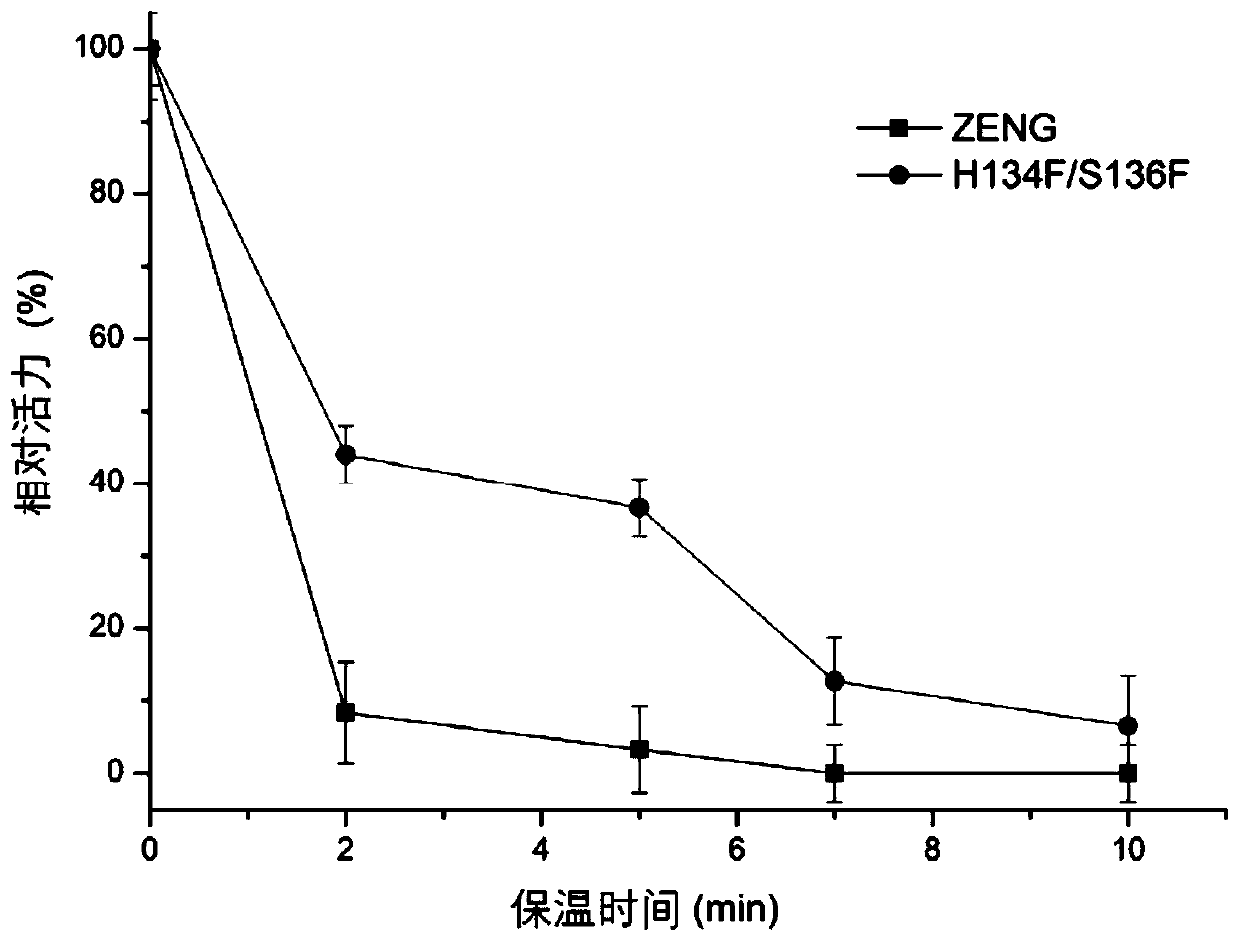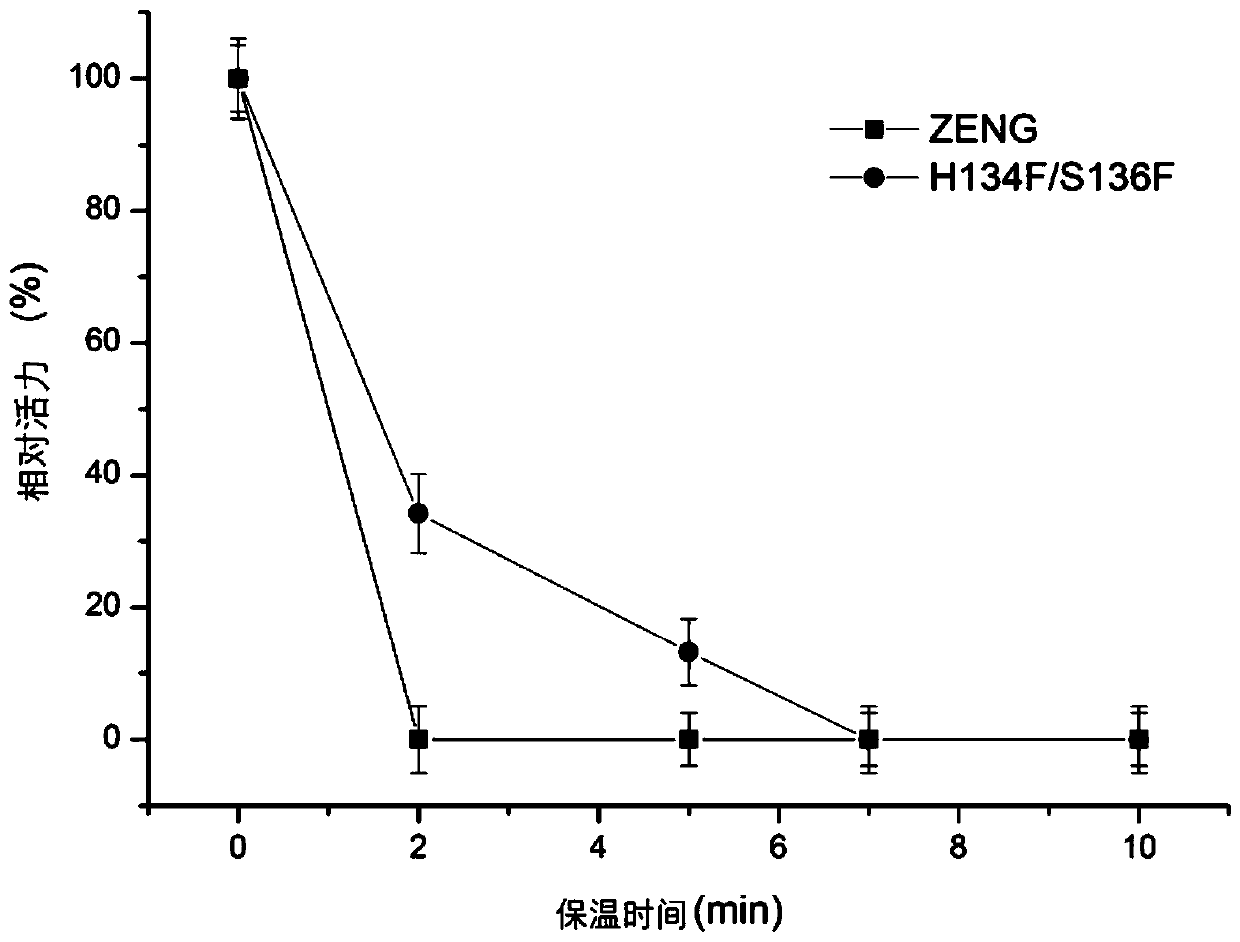Fungaltoxin ZEN degrading enzyme mutant and application thereof
A technology of mycotoxins and degrading enzymes, applied in the field of bioengineering, can solve the problems of insufficient research on the principle of enzyme degradation and transformation of ZEN, easy decline and instability of degrading bacteria functions, etc.
- Summary
- Abstract
- Description
- Claims
- Application Information
AI Technical Summary
Problems solved by technology
Method used
Image
Examples
Embodiment 1
[0030] Embodiment 1: the preparation method of ZENG enzyme mutant
[0031] Select ZENG degrading enzymes from different microbial sources, analyze the differences in their thermal stability, and compare their respective amino acid sequences; at the same time, based on the crystal structure that has been resolved, it is analyzed that the residues at positions 134 and 136 are exactly The "cap" region and the core catalytic domain in the ligase structure. For this reason, different ways of site-directed mutagenesis were chosen for the 134-position and 136-position residues.
[0032] Construction of pET-22b(+)-H134F / S136F mutant plasmid:
[0033] According to the gene encoding zearalenone degrading enzyme derived from Gliocladium roseum MA 918 (accession number: KR363960.1), the gene for ZEN degrading lactone hydrolase was synthesized and linked to the restriction site of pET-22b(+) Between Nde I and Xho I, the recombinant plasmid pET22b(+)-ZENG was obtained. Using the pET-22b(...
Embodiment 2
[0053] Example 2: Expression and purification method of mutant enzyme H134F / S136F
[0054] The mutant plasmid pET-22b(+)-H134F / S136F verified by sequencing was transformed into Escherichia coli BL21(DE3) cells, and the positive transformants were picked and cultured overnight in LB medium at 37°C and 200rpm in shake flasks, and then inserted into LB Culture the medium at 37°C for 3-4h until the OD value is 0.6-0.8, cool down to 28°C, add IPTG at a final concentration of 0.6mM to induce for 6h.
[0055] The fermentation broth was centrifuged at 4°C and 10000rpm for 20min, and the cells were collected. Add 20mL of buffer solution (50mM Tris, 200mMNaCl, HCl to adjust the pH to 8.5) to fully resuspend the bacteria, then place the centrifuge tube in an ice bath and put it into an ultrasonic cell disruptor. The conditions for ultrasonic disruption are: working time 1s, The stop time is 2s, a total of 18min. The obtained crushed solution was subjected to low-temperature high-speed ...
Embodiment 3
[0056] Example 3: Thermostability determination of mutant enzyme H134F / S136F.
[0057] The parent enzyme and the mutant enzyme H134F / S136F were incubated at 53°C and 58°C for a period of time to measure the remaining enzyme activity. The initial enzyme activity at 0 time of incubation at 53°C and 58°C was 100%, and the specific enzyme activity was 69U respectively. / mg and 29U / mg. Compared with the parent enzyme ZENG, the optimal catalytic conditions of the ZENG mutant enzyme H134F / S136F did not change, but the residual enzyme activity of the enzyme after incubation at 53°C for 2 minutes increased by 36%; after incubation for 5 minutes, the residual enzyme activity increased 33%; after incubation for 7 minutes, the residual enzyme activity increased by 12%. After incubation at 58°C for 2 minutes, the residual enzyme activity increased by 34%, and after incubation for 5 minutes, the residual enzyme activity increased by 13% (see figure 1 and figure 2 ).
PUM
 Login to View More
Login to View More Abstract
Description
Claims
Application Information
 Login to View More
Login to View More - R&D
- Intellectual Property
- Life Sciences
- Materials
- Tech Scout
- Unparalleled Data Quality
- Higher Quality Content
- 60% Fewer Hallucinations
Browse by: Latest US Patents, China's latest patents, Technical Efficacy Thesaurus, Application Domain, Technology Topic, Popular Technical Reports.
© 2025 PatSnap. All rights reserved.Legal|Privacy policy|Modern Slavery Act Transparency Statement|Sitemap|About US| Contact US: help@patsnap.com



